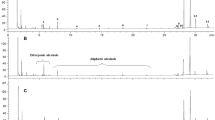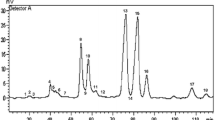Abstract
In this study, the quality characteristics, i.e., the acidity and acylglycerols, of currently produced Mallorcan oil was analyzed by titration and gas-chromatographic technique, respectively, in approximately 400 samples of monovarietal olive oil made from three genetic varieties (Arbequina, Empeltre, and Picual) on the island of Mallorca during the 2003/2004 and 2005/2006 seasons, and the differences in the compositions were discussed. Composition analysis showed that free fatty acids (FFAs) and DAGs were produced mainly by hydrolysis of triacylglycerols (TAGs). Fruit storage tests revealed that hydrolysis occurred during storage of olive fruits. The DAG content was higher in oil with higher acidity, but the maximal DAG content was only about 10 with 30% acidity, and the primary isomer found in Mallorcan oil was 1,3-DAG. However, the chiral-chromatographic study on the ratio of sn-1,2-DAG to the sum of sn-1,2-DAG and sn-2,3-DAG in a slightly hydrolyzed oil sample indicated that Empeltre and Picual fruits possess an sn-3-enantioselective lipase that leads to accumulation of sn-1,2-DAG. In currently produced Mallorcan oil, significant isomerization appears to occur and hydrolysis of the resulting 1,3-DAGs seems to lessen DAG accumulation.




Similar content being viewed by others
Abbreviations
- DAG:
-
Diacylglycerol
- TAG:
-
Triacylglycerol
- MAG:
-
Monoacylglycerol
- FFA:
-
Free fatty acid
- GV:
-
Genetic variety
- HS:
-
Harvest season
References
D’Alonzo RP, Kozarek WJ, Wade RL (1982) Glyceride composition of processed fats and oils as determined by glass capillary gas chromatography. J Am Oil Chem Soc 59:292–295
Salas JJ, Sanchez J, Ramli US, Manaf AM, Williams M, Harwood JL (2000) Biochemistry of lipid metabolism in olive and other oil fruits. Prog Lipid Res 39:151–180
Sanchez J, Harwood JL (2002) Biosynthesis of triacylglycerols and volatiles in olives. Eur J Lipid Sci Technol 104:564–573
Pereira JA, Casal S, Bento A, Oliveria MBPP (2002) Influence of olive storage period on oil quality of three Portuguese cultivars of Oleo europea, Cobrancosa, Madural and Verdeal Transmontana. J Agric Food Chem 50:6335–6340
Spyros A, Phillippidis A, Dias P (2004) Kinetics of diglyceride formation and isomerization in virgin olive oils by employing 31PNMR spectroscopy. Formulation of a quantitative measure to assess olive oil storage history. J Agric Food Chem 52:157–164
Fronimaki P, Spyros A, Christophoridou S, Dais P (2002) Determination of the diglyceride content in Greek virgin olive oil and some commercial olive oils by employing 31P NMR spectroscopy. J Agric Food Chem 50:2207–2213
Perez-Camino MC, Moreda W, Cert A (2001) Effect of olive fruit quality and oil storage practices on the diacylglycerol content of virgin olive oils. J Agric Food Chem 49:699–704
Catalano M, De Leonardis T, Comes S (1994) Diacylglycerols in the evaluation of virgin olive oil quality. Grasas y Aceites 45:380–384
Gomes T, Caponio F, Delcuratolo D (2003) Non-conventional parameters for quality evaluation of refined oils with special reference to commercial class olive oil. Food Chem 83:403–408
Barceló Mairata I, Barceló Mairata F (1985) Analisis de la Composicion Lipidica del Aceite de Oliva Virgen de Mallorca. Grasas y Aceites 36:269–273
Angerosa F, Campestre C, Giansante L (2006) Analysis and authentication. In: Boskou D (ed) Olive oil: chemistry and technology, 2nd edn. AOCS press, Chanpagne
Commission Regulation (EEC) No 2568/91 of 11 July 1991 on the characteristics of olive oil and olive-residue oil and on the relevant methods of analysis. Off J Eur Union L 248:1–83
Shimizu M, Moriwaki J, Nishide T, Nakajima Y (2004) Thermal diacylglycerol and triacylglycerol oils during deep-frying. J Am Oil Chem Soc 81:571–576
Itabashi Y, Kukis A, Marai L, Takagi T (1990) HPLC resolution of diacylglycerol moieties of natural triacylglycerol on a chiral phase consisting of bonded (R)-(+)-1-(1-Naphthyl) ethylamine. J Lipid Res 31:1711–1717
Shimizu M, Kudo N, Nakajima Y, Matsuo N, Katsuragi Y, Tokimitsu I, Barceló F (2008) Effect of lipase activity and specificity on the DAG content of olive oil from the Shodoshima-produced olive fruits. J Am Oil Chem Soc 85:629–633
Acknowledgments
We would like to thank Oli-Caimari in Palma of Mallorca (Spain) for the donation of the olive oil samples. We also acknowledge collaboration with the University of the Balearic Islands (“Fundació Universitat Empresa de Les Illes Balears, FUEIB”).
Author information
Authors and Affiliations
Corresponding author
About this article
Cite this article
Shimizu, M., Kudo, N., Nakajima, Y. et al. Acidity and DAG Content of Olive Oils Recently Produced on the Island of Mallorca. J Am Oil Chem Soc 85, 1051–1056 (2008). https://doi.org/10.1007/s11746-008-1292-0
Received:
Revised:
Accepted:
Published:
Issue Date:
DOI: https://doi.org/10.1007/s11746-008-1292-0




